|
Root Canal
Root Canal
Q: What is a root canal?
A: There is a separate compartment inside each tooth. If we cut the tooth in half, we will see that this compartment starts at the tip of the root (apex) as a shallow canal, widening and entering the crown part of the tooth-pulp chamber. Blood and nerves enter the tooth thru the apex forming the tissue-pulp. This pulp occupies the space inside the tooth (canal and the pulp chamber) bringing all necessary nutrition to the tooth structure through its vessels and it is protected from outside by healthy dentin and enamel.
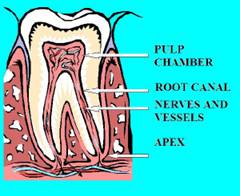
Q: Why do we need Root Canal Treatment?
A: If the nerve gets inflamed the root canal treatment is necessary to save the tooth. The most common reason for the nerve infection (pulpit) is untreated caries reaching the pulp chamber. Once the caries reaches the nerve, root canal treatment becomes necessary. Occasionally trauma or severe gum disease can cause nerve damage as well. Pulpit can cause unbearable pain, hardly controllable by even the strongest painkillers. Pain would increase during the night hours. Hot and cold would increase pain, and it would last for some time. If left untreated the nerve dies and the inflammation spreads thru the apex into surrounding bone causing the inflammation there and leading to periapical abscess. As the abscess develops, it dissolves bone around the apex of the tooth substituting it with soft tissue. It is like a sac with pus growing and “eating” the bone. Patients may feel pain biting on the tooth. Swelling develops. Left untreated these infections will continue to spread, causing more and more complication, sometimes very serious and life threatening. In many cases, patients may not feel pain, or pain may be of short duration not causing real problems. The lack of pain does not mean that there is no need for the root canal.
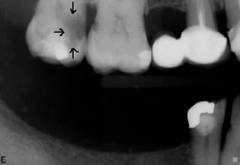 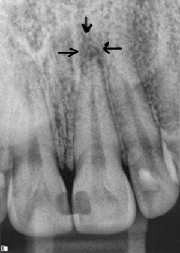
Q: How is Root Canal Treated?
A: Depending on the symptoms and the stage of the disease, Root Canal Treatment may take one or more visits. The objective of RCT is to clean all the infected tissue out of the canals of the tooth and seal them with special insoluble material- gutta-percha. First doctor will anesthetize the patient with anesthetic solution. After patient is numb, doctor will remove the decay and “open” the tooth to gain access to the nerve. Nerve could be live or already dead depending on the stage of pulp disease. After the crown part of the nerve removed, doctor using special files will clean the inside of canals, widen them and shape them. During the instrumentation, the inside of the canals will be washed (irrigated) with antiseptic solutions. Then canals will be dried with special paper points and sealed with gutta-percha. Gutta-percha has to fill the whole length of the canal up to the apex. Usually doctor will file tooth slightly down, to keep it out of occlusion to prevent pain and place temporary filling. It is very strongly recommended to restore any endodonticly treated tooth with post and core and the crown.
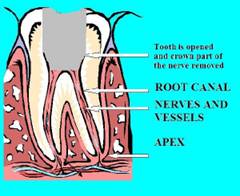
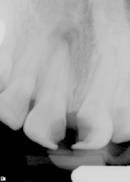 |
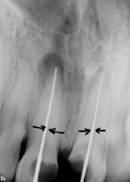 |
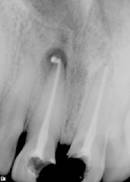 |
| Decay leading to the nerveand periapical infection |
Endodontic file used to take measurement |
Completed RCT on two Central incisors |
It may take up to six month for the infection to heal. After RCT treatments were completed, Post and Cores and crown were used to restore each of those teeth
Q: Root Canal Re-treatment
A: Do Root Canals always work? Unfortunately not. The success rate for the root canal treatment according to different studies is 92-96%. Sometimes root canal failures can be attributed to poorly sealed canals, but some times x-ray shows perfectly sealed canal and the periapical infection is still there. What are the options if endodontically treated tooth has the infection? There are few procedures, which could be done to save the tooth.
The most conservative one would be a Root Canal Re-Treatment procedure. During this procedure, the doctor will remove any restorations the tooth may have to gain access to the pulp chamber, remove all old filling material from the canals, and do the root canal treatment from scratch as described before. If successful, the periapical infection seen on the x-rays will start to disappear. The principle is to eliminate the cause, and the immune system does the rest. The images of x-ray show huge infection around the roots of previously endodonticly treated tooth almost disappear in ten weeks after procedure was done. It can take 6 month before bone fully restore after the treatment
| Rct was done and failed |
10 weeks after retreatment |
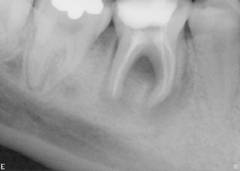 |
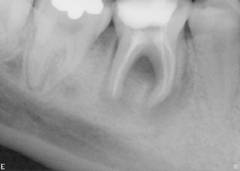 |
| The dark area around the roots is the infection |
Notice bone regeneration |
back to the top
|
|
|
